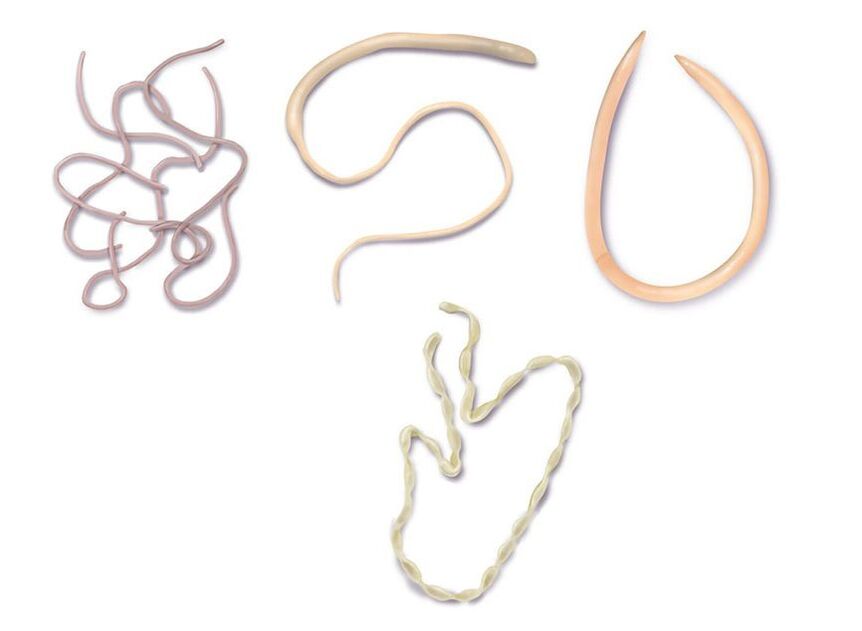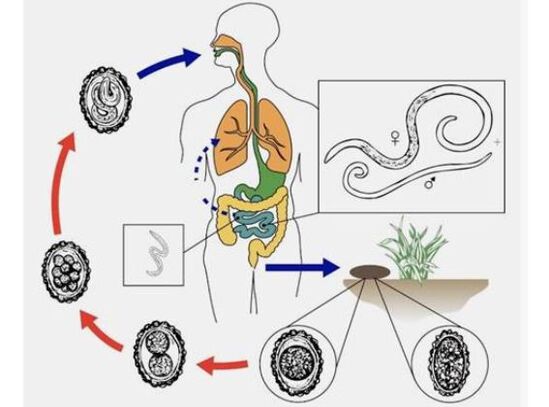Parasitesis a very common phenomenon that can be easily detected in most people during a normal medical examination.
Specialists have many methods and techniques for identifying and diagnosing worms in the body of a child and an adult. Given the current state of medical development, this is completely uncomplicated. In addition, many helminths can be recognized independently by leaving the body and entering the external environment. This process usually occurs when the female reproduces and lays eggs.
Further determination of the type, quantity and duration of the life cycle of worms in humans must be carried out in specialized clinics as part of a full examination.
Types of worms in humans

Representatives of helminths are identified based on general characteristics, as well as lifestyle, life cycle and developmental characteristics. It also takes into account how worms manifest themselves in humans, how long they live in the body and what diseases they cause.
Doctors can detect the presence of the following types of worms in the body:
- nematode, roundworm.The life cycle is no more than 40 years; they parasitize in the intestines. May affect the respiratory tract and stomach. Representatives: pinworms, roundworms, whipworms;
- Ribbon parasites.They can live in the intestines and migrate through the body for about 20 years. Large sizes reach 8-10 meters. Individuals of bovine and pork tapeworms, tapeworms;
- Leeches, trematodes.They occur in the internal organs and subcutaneous tissue. It spreads through all organs and can be life-threatening.
Each of the above groups has representatives that are most common in humans.
And each of them poses a serious threat to health and the normal functioning of the body:
- roundwormMay cause: appendicitis, jaundice, inflammation of the bile ducts;
- Pinworm.Leads to complications: gastritis, allergic reactions, nervous disorders;
- WhipwormMay cause dysentery and rectal prolapse;
- Toxocara.Manifested by decreased vision, bronchitis, necrosis of the pancreas, liver, kidneys, disruption of brain function;
- Echinococci.It poses a danger in the form of anaphylactic shock, urticaria, liver enlargement, cyst formation and death;
- Trichinae.May lead to the formation of infiltrations and damage to the heart and brain;
- Giardia.Consequences: anemia, gastritis, Quincke's edema, pancreatitis;
- Hookworms.May cause intestinal dysfunction;
- wide band.Promotes the development of anemia, hypovitaminosis, necrosis of intestinal tissue and damage to the spinal cord;
- Filariae.Can cause diseases: conjunctivitis, lymphadenitis, asthma, abscesses; Lung fluke. They provoke enteritis, bronchitis, fever, meningitis and tachycardia.
These are just a few of the parasites that are commonly mentioned. There are worms that are less dangerous but still harmful. Therefore, it is important to study them under laboratory conditions.
Infection with worms

It is not difficult for parasites to penetrate the human body. It is impossible to detect or identify them in the environment because they are often in the stage of small larvae or microscopic eggs.
There are certain methods and routes of infection:
- Water bodiesFor most parasites, the larvae spend the intermediate stages of their life cycle in both fresh and salt water. Sometimes they occur in intermediate hosts such as fish and shellfish;
- wet sand or earth. Together with the feces, eggs are mainly released for further development or in search of a temporary carrier;
- dirty unprocessed vegetables, berries, fruits, herbs. From the ground, future parasites penetrate the surface of the products;
- Animals: Homeless people and pets. Temporary media.
Even an ordinary walk with a child or a trip to the store, calling the elevator or dirty handrails can lead to the emergence of parasites. To prevent this, it is necessary to follow simple rules of personal hygiene, regularly wet clean the house and ventilate the room where the workplace is located.
Worms in an adult, their signs and symptoms

Characteristics alone cannot clearly determine whether a person has a helminth infestation.
How can you check if you really have worms?
For this purpose, there are general characteristic signs of the presence of worms in a person and methods for determining them:
- Changes in appetite, including its increase and decrease;
- Nervousness, fear, excitement. Fatigue and weakness may also occur;
- Snoring, difficulty breathing during sleep;
- intestinal problems, including diarrhea and constipation;
- flatulence;
- headache, dizziness;
- swelling of the limbs;
- itching in the anus;
- increased body temperature;
- fluctuations in blood pressure;
- rashes, redness;
- nausea, vomiting;
- pain in stomach;
- Brittleness of hair and nails.
These are just a few signs that may indicate the presence of worms in an adult. However, these symptoms can also be characteristic of other diseases. Therefore, only a proper examination allows an accurate result.
Signs of worms in children
Since immunity and protective protein cells are still insufficient in children, they are often more susceptible to more serious consequences of the presence of parasites in the body:
- intestinal dysfunction, dysbacteriosis;
- flatulence, flatulence;
- skin inflammation, urticaria;
- involuntary urination or urinary incontinence;
- Respiratory diseases. bronchitis, pneumonia, asthma;
- Inflammation of the genital organs is possible in girls;
- vomiting, nausea;
- itching and burning in the anus;
- severe aching abdominal pain and colic;
- sleep disorder;
- Nervousness,
- Serious complications or developmental delays can occur in newborns.
It is quite difficult to identify worms on your own, and many parents do not think about their presence. If they try to treat their children without the help of specialists, they can worsen the spread of parasites in the children's body. The consequences in such cases are unpredictable.
Tests for various worms

How to understand that a person is developing helminthiasis?
Accurate determination of the presence of worms in adults and children is possible only with the help of specially developed research methods.
Depending on the symptoms and signs of parasites, the doctor prescribes appropriate research methods:
- ScrapeThis is a traditional and simple method that involves taking a swab from the anus to detect the presence of worm eggs.
- Stool analysis.This method has been tested, but is not always effective because not all helminths are present in discharge;
- chemical general blood test.It allows you to determine only the inflammatory process by indicators of low hemoglobin and also takes into account leukocytes;
- CPR diagnosis. This method examines the parasite DNA material found in the blood in comparison to available samples. It allows an accurate determination of the class of helminths and their quantity;
- Linked immunosorbent assay.This method is also based on the analysis of the patient's blood. The detected samples of IgM and IgG antibodies indicate a protective reaction of the immune system to worms.
Additionally, ultrasound, radiography and tomography can be prescribed. Their need is associated with the migration of parasites through the organs and their frequent change of location. To obtain material from the affected organs, the method of biopsy or probing is also used. The choice of diagnostic method depends on the class of helminths and the effect on the organs.
Worms: treatment for adults and children
It is important to know that the treatment of diseases caused by helminth infections is in most cases complex. It is not always possible to completely remove the larvae and eggs of all parasites in one treatment. Patients often need to be under constant medical supervision and undergo regular testing.
What should be done in this case?
It is important to follow your doctor's advice and recommendations.
Typically, medications with a broad spectrum of action are prescribed.
Particular caution should be exercised when taking medications for small children and newborns. The powerful components of medical anthelmintics are not always suitable for an organism with low immunity.
Only an experienced doctor can prescribe medications appropriate to the patient's age and the degree of complication of the disease.
FAQ
What symptoms can indicate the presence of worms in a person?
Symptoms of worms may include constant fatigue, weight loss, insomnia, itching in the anus, worms in the stool, and abdominal pain.
What diagnostic methods are used to determine the presence of worms in a person?
To diagnose worms, stool tests for worm eggs, a blood test for antibodies to worms, and survey diagnostic procedures such as ultrasound and X-rays can be used.
Helpful advice
Tip #1
Watch for symptoms that may indicate the presence of worms, such as constant fatigue, loss of appetite, stomach pain, difficulty sleeping, and allergic reactions.
Tip #2
Contact your doctor for specific stool or blood tests to check for worm eggs or antibodies to them.






























